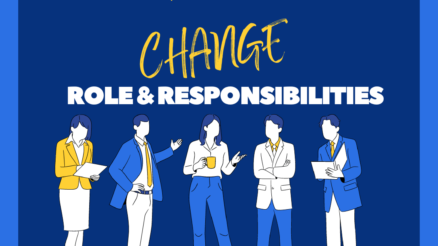Dr Kurt Lewin was among the early social scientists and theorists of change management. He presented his three stage model of change management in 1947, which was very popular among the academia and practitioners of change management.
His work laid the foundation of change management as a specialized area of study. His model was widely discussed, debated and later challenged by other social scientists. But this three-stage model- Unfreeze- Change- Freeze which is also called Changing As Three Steps (CATS) holds significance even today.
In this blog post, we’ll look at each of three stages of Lewin’s model of change management and how it explains the process of change management.
Let’s start reading
Unfreezing
Do we put frozen meat straight to cooker?
No!
Why?
because it is not yet ready. You are always advised to first unfreeze meat and then start cooking. The same holds true for any change to happen at organization level.
The first stage, according to Lewin, is called unfreezing and it is about how much you are ready for change.
How much employees understand that change is necessary and status quo is no longer working for them. This stage is also about creating motivation among employees to accept and implement change.
In this stage, role of change leaders is extremely important. They need to challenge the old mind-set of employees, and give them a picture of change or share the vision of change.
For all this to happen, communication is the key. The more coherent, frequent and powerful communication, the more effective and smooth unfreezing stage will be.
Change
When something is unfrozen then it moves toward a new process.
Like after accepting the new realities and vision, the next stage is when actual change happens. It is a stage of transition.
It is a real journey of change. It involves moving toward the real goal by implementing change.
It is not that easy transition.
Why?
People hate uncertainties, they are not comfortable in undertaking new roles and responsibilities. Therefore, it is extremely important to make proper planning and do effective communication and appreciate everyone involved in the transition.
In this process everyone involved in it should be prepared to implement change. Change leaders should be telling employees very often that what are reason and vision of change. Benefits of change should also be reminded to employees so that to keep their motivation intact.
Freezing
Freezing symbolizes stability, consolidation and sustainability. This stage is all about sustaining the change within organization. That is why Lewin named this stage ‘freezing” but some other theorists refer it to as refreezing.
After reaching the required destination of change the next logically step is how to sustain that change. So, it is about freezing the achieved status of change in organization.
At this stage, the change has become culture and new norm of organization. Employees has settled in their new roles and responsibilities and adopted completely to the change.
There might be new processes, systems, structures, resources etc. So freezing entails all of these within organization so that the lasting benefits of change are achieved over period of certain time.
Lewin argues that employees should be given rewards, be acknowledged and recognized for all their work done in achieving the real change. And this reward and recognition system also works to sustain and strengthen the change.
Why to Choose Lewin’s Change Model
There are several reasons why an organization may choose to use Lewin’s Change Model for managing change:
1. Easy to understand and implement
Lewin’s change model is easy to understand for both change leaders and employees. When leaders and management share their vision and reason for change to employees, questions pop up in the minds of employees about how this change will happen, what will be the process, what will be the future etc.
By using Lewin’s change model, leaders can easily explain to them that what will be three stages of change in their organization; and what will be roles and responsibilities of leaders and employees.
2. Smooth transition and sustaining change
The three stage change model also allows smooth transition from one stage to another. Using this model, change leaders have more clarity about the process of change and progress being made towards the real goal.
Transition from one stage to another also gives time to change leaders to reflect on the success and challenges and they can take corrective actions to ensure smooth transition and also sustain change which is the key idea of the last step of this model.
3. Gradual change
Since Lewin’s change model emphasize on sequential change. It is not like that parallel things are happening. It starts from step one and then gradually to next and then the final. It more gradual change instead of haphazard change.
These steps allow change leaders enough time to implement the change in its original sense. And by this way organizations actually make real transition or transformation.
4. It is based on empirical research
Kurt Lewin was a renowned social psychologist who developed the model based on his research on how people behave in groups. The model is therefore grounded in empirical evidence, which makes it a reliable and effective approach to managing change
5. It emphasizes the importance of involving people
One of the key principles of the Lewin Model is the importance of involving people in the change process. This means that employees are more likely to feel engaged and committed to the change, which increases the chances of success
Limitations of Lewin’s Model of Change Management
While the Lewin model of change management is a useful framework for managing change, it is not without its limitations. Some of the main limitations of the Lewin Model include:
- It is a linear model: The Lewin Model is a linear model that assumes that change occurs in a straightforward and predictable sequence of stages. In reality, change can be much more complex and unpredictable, and may not follow a linear path.
- It is a top-down approach: The Lewin Model assumes that change is initiated by leaders or managers at the top of the organization, who then implement the change throughout the organization. This can lead to resistance from employees who feel excluded from the process or who do not understand the need for the change.
- It assumes a stable environment: The Lewin Model assumes that the environment is stable and that change is initiated in response to a specific problem or opportunity. In reality, the business environment is often turbulent and unpredictable, and change may be necessary for reasons that are not immediately apparent.
- It may not account for individual differences: The Lewin Model assumes that all individuals will respond to change in the same way. In reality, individuals may have different levels of readiness for change and may require different approaches to support them through the change process.
- It may not account for cultural differences: The Lewin Model assumes that all organizations are the same and will respond to change in the same way. In reality, different organizational cultures may require different approaches to managing change.
Despite these limitations, the Lewin Model is still a valuable framework for managing change, particularly in situations where the change is relatively straightforward and the organizational culture is stable. However, it is important to recognize its limitations and adapt the approach as needed to account for the complexities of the change and the unique needs of the organization and its employees.
Take Home Points
- Lewin outlines three stage model of change model to explain the stages of change and how it is implemented and managed in organizations.
- First stage is unfreezing which basically revolves around getting people ready to start the journey of change.
- Second stage is change which talks about transition and what does it entail to experience the process of transition.
- Third and the last stage is freezing which is all about the stability and how change is institutionalized in the culture of an organization.
- Critics say that Lewin model of change is over simplistic. Change is not an easy process and present day business it is chaotic and there are multi factors which affect the change.



